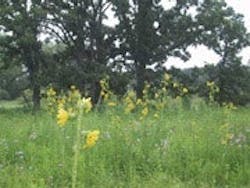UW-Madison Arboretum to Undergo Storm Water Facelift
Almost a half billion gallons of urban runoff gushes into the University of Wisconsin (UW)-Madison Arboretum each year, bringing with it a host of problems. Nearly every storm water pond, ditch and flume on Arboretum property has failed. A delta of eroded sediment is spreading its muddy fingers across Lake Wingra's western end, and large swaths of the Curtis and Greene prairies--among the oldest and finest restored prairies in the world--have succumbed to a runoff-loving invasive grass.
Situated downhill from most its urban surroundings, the Arboretum is unlikely to see less runoff anytime soon. However, the incoming water can be handled more effectively, which is the goal of a new set of storm water management facilities the Arboretum is starting to build in cooperation with the cities of Madison and Fitchburg, the town of Madison and the Wisconsin Department of Transportation (DOT).
"I think this partnership is important. We all recognize there's a problem, and we're all seeking solutions to fix it," said Arboretum Director Kevin McSweeney. "It's not that the Arboretum expects to stop getting water from the outside, but we want to be able to manage what comes to us in a much more controlled way."
Traveling underground in pipes from places as near as the Vilas neighborhood and as far away as Research Park and Orchard Ridge, storm water has for decades discharged into the Arboretum and wended its way into Lake Wingra and Wingra Creek. But as urban development in the watershed has risen, so has the amount of runoff coursing across the property, causing widespread erosion, degrading wetlands and carrying in sand and pollutants from city streets.
The projects now launching to address these problems were developed by a group called the Arboretum Storm Water Committee, with extensive help from UW-Madison researchers across campus, as well as city engineers and private consultants. Fixing or replacing the Arboretum's existing storm water ponds and channels is the primary aim. But each project will also serve the Arboretum's core missions of education and research, according to Committee Chair David S. Liebl.
The new facilities are being paid for through a combination of university, city and DOT funds, with UW-Madison contributing extra money in some cases to support a research component, Brown said. Seven projects are currently planned, and Liebl estimates the entire endeavor will take about five years to complete. Yet this is just the beginning, he adds. To truly solve the Arboretum's runoff woes, homeowners and businesses will also need to pitch in by, for example, building rain gardens.
"After the existing problems are fixed, the question is what can we do in the surrounding watershed and community to reduce the impact of storm water?" Liebl said. "Because in 15 or 20 years when these storm water facilities need to be rehabilitated again, we want to be looking not at a worse situation than we have now, but a better one."
Source: Media-Newswire


